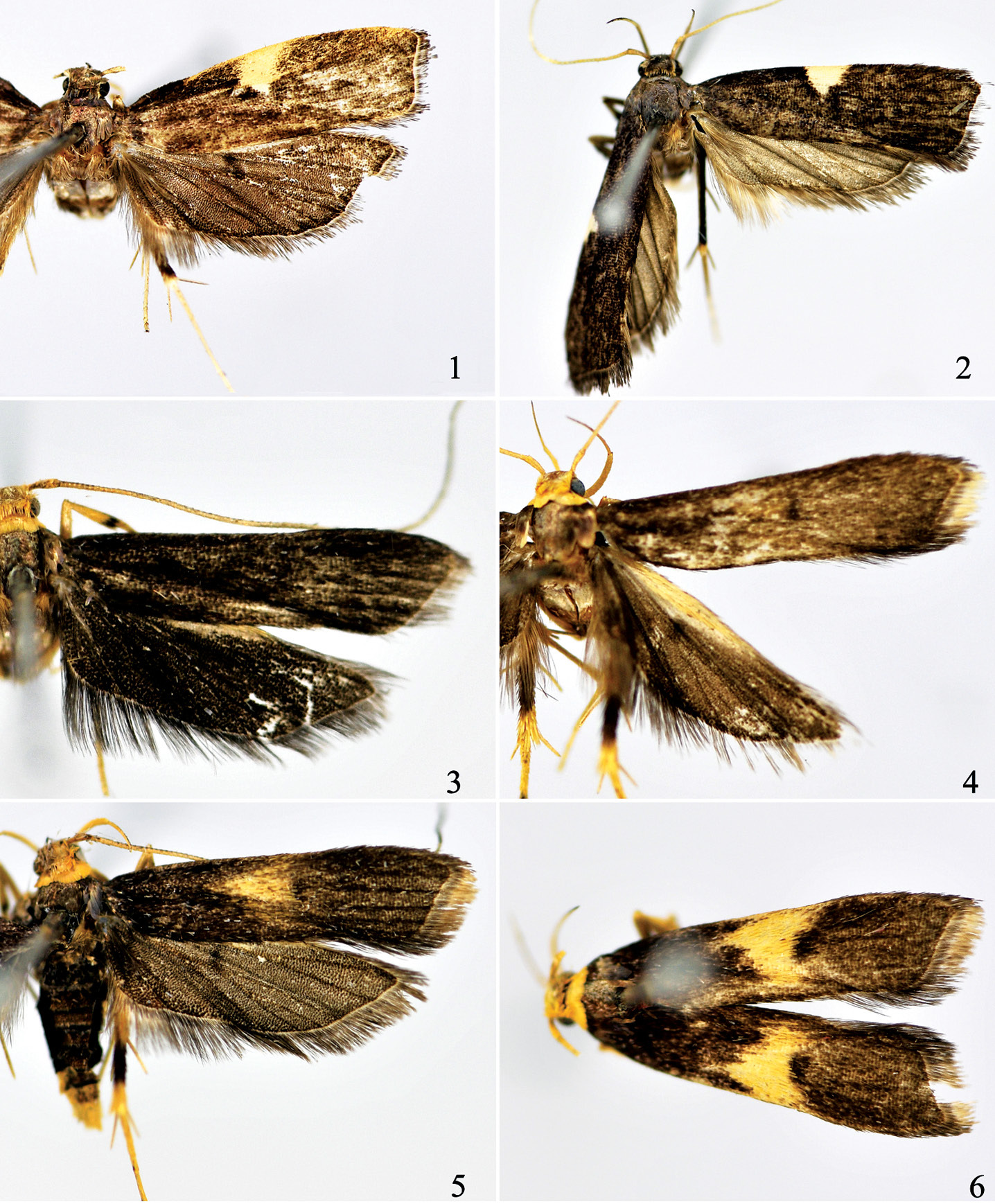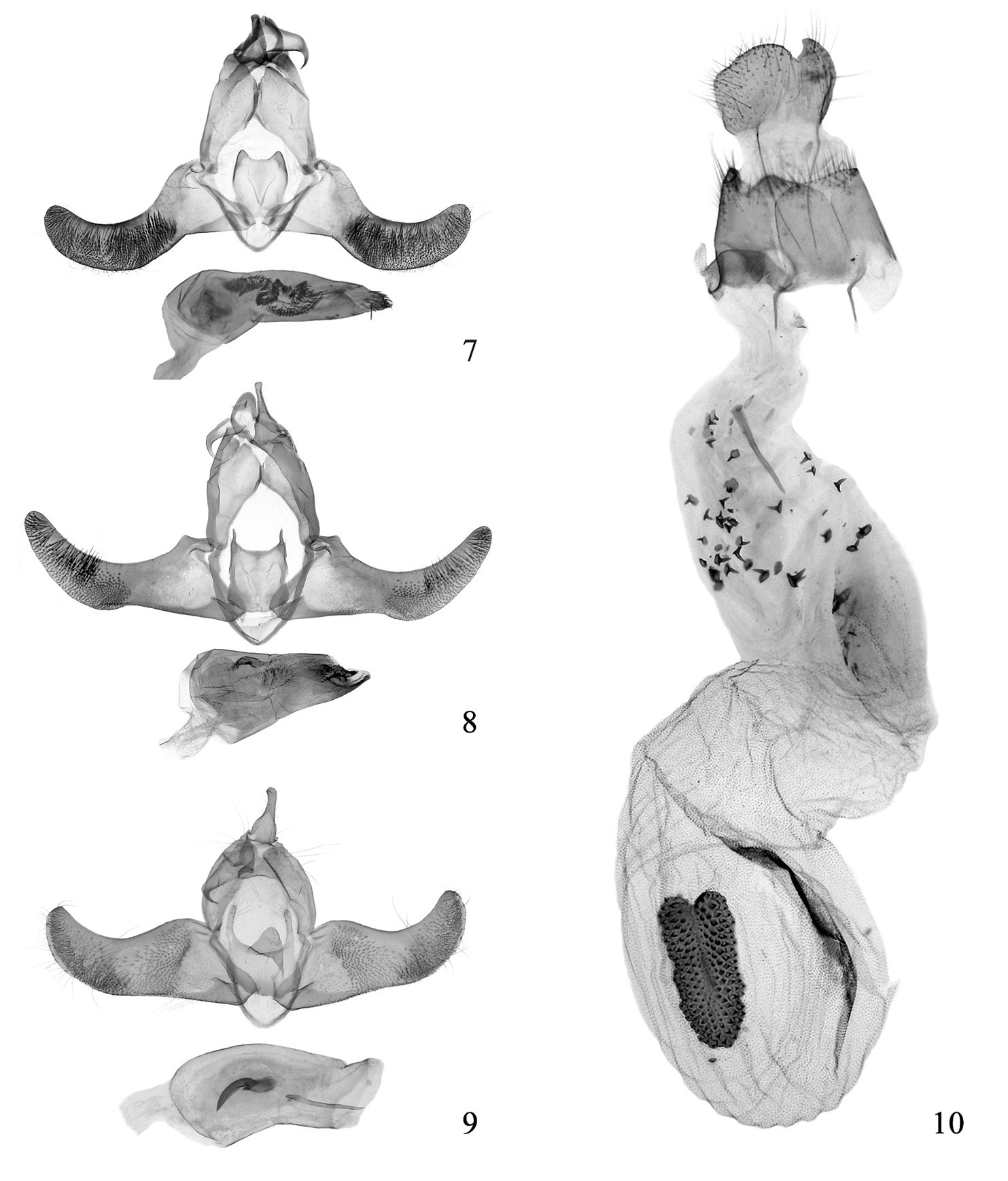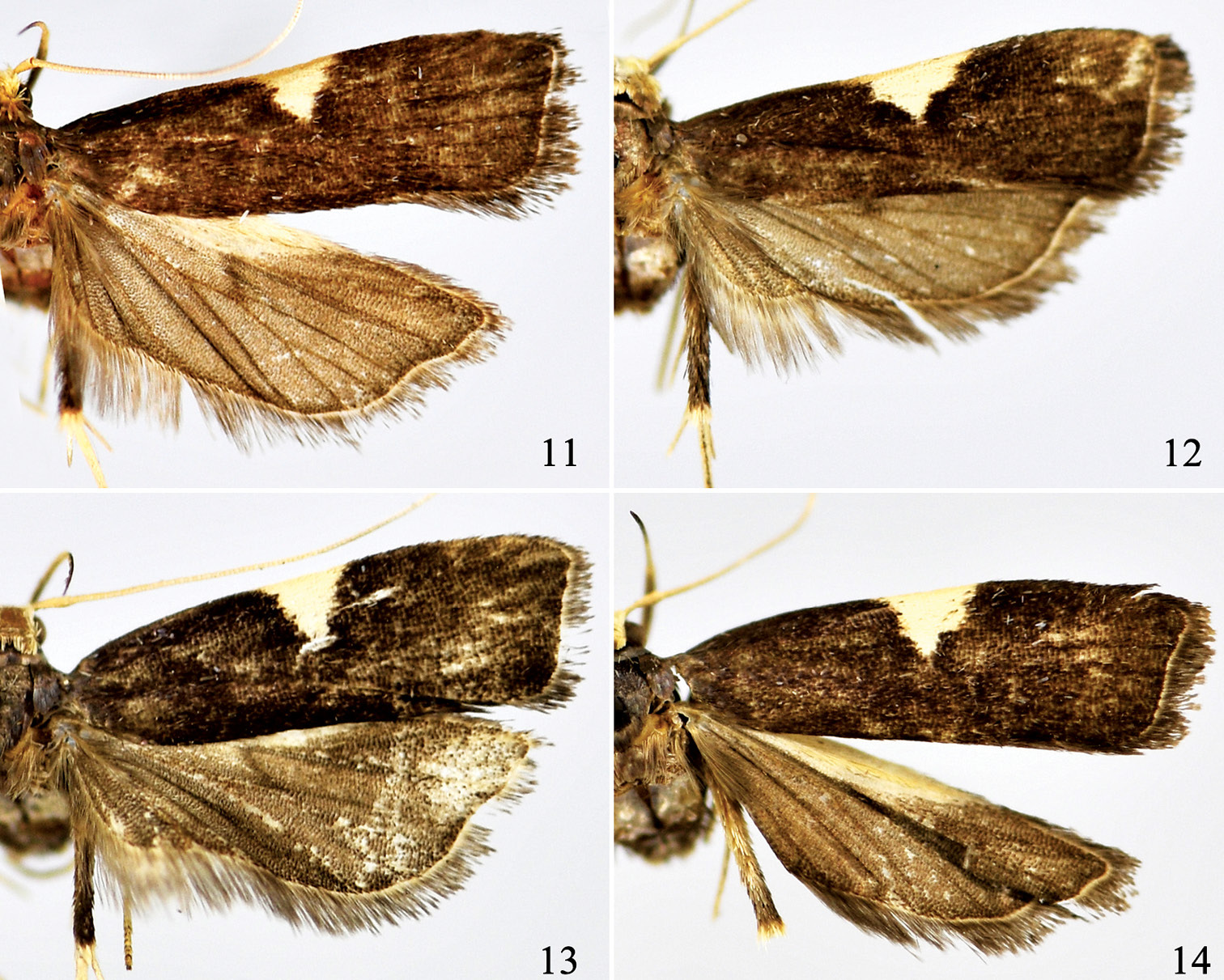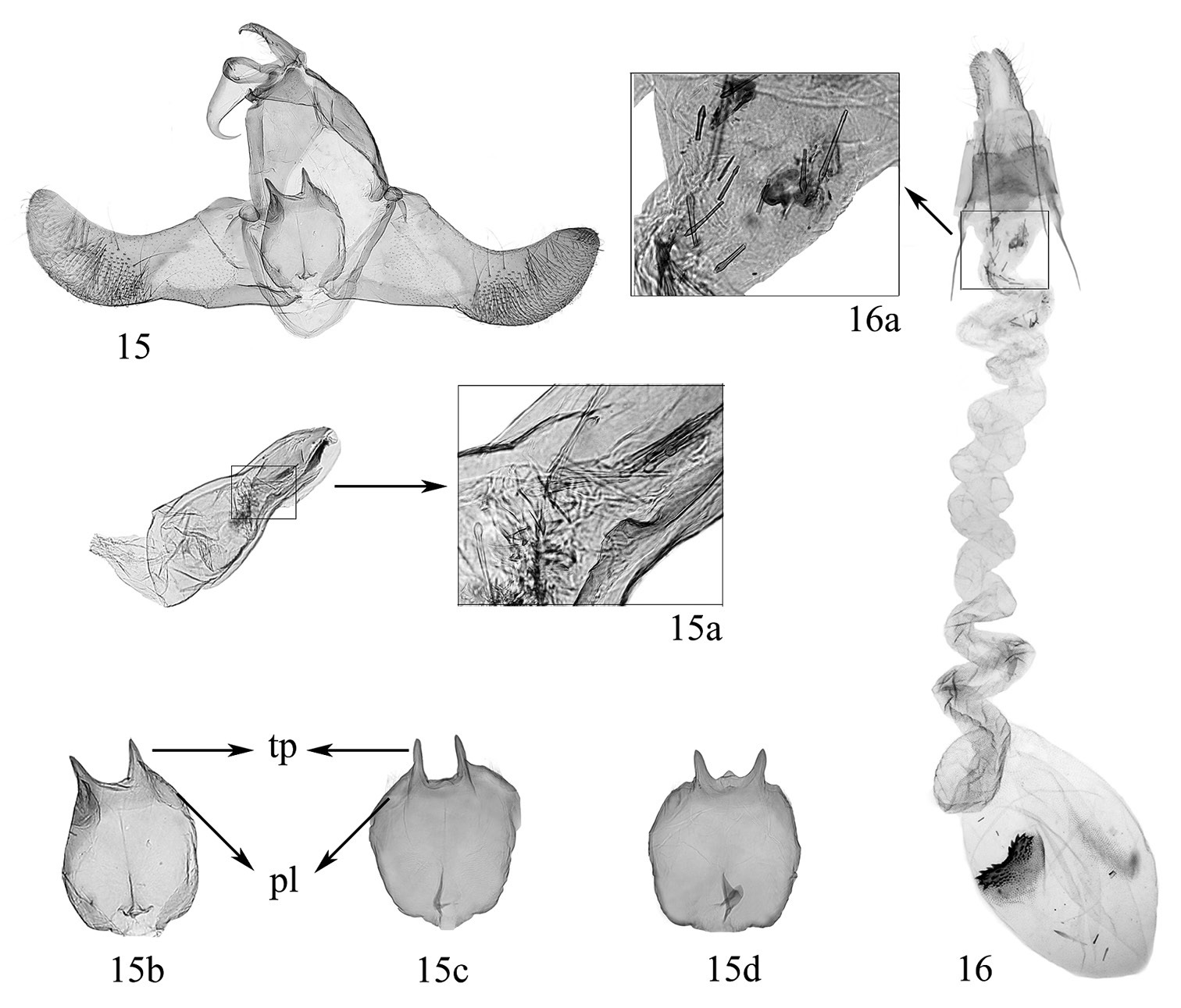(C) 2010 Linlin Yang. This is an open access article distributed under the terms of the Creative Commons Attribution License, which permits unrestricted use, distribution, and reproduction in any medium, provided the original author and source are credited.
For reference, use of the paginated PDF or printed version of this article is recommended.
The genus Thubana Walker is reviewed for China. Nine species are recognized, of which Thubana felinaurita Li, sp. n. is described as new; Thubana dialeukos Park, 2003 and Thubana xanthoteles (Meyrick, 1923) are newly recorded for this country; Thubana stenosis (Park, 2003), syn. n. is synonymised with Thubana xanthoteles, and Thubana microcera (Gozmány, 1978), syn. n. with Thubana leucosphena Meyrick, 1931. Images of adults and genitalia are provided. A checklist of Thubana species in China is included, along with a key to these species.
Lepidoptera , Torodorinae , Thubana , new species, synonym, China
The genus Thubana was established by
Prior to this study, seven species of Thubana were recorded in China (
Genitalia dissections were carried out following the methods described by
Thubana is characterized by the combination of the following characters: forewing often having a white costal patch, costa gently curved with sharpened end, termen more or less concave, tornus broadly rounded, M3 usually stalked with CuA1+2, R4 and R5 often coincident (insome species R4 and R5 stalked basally), R3 stalked with R4+5; hindwing with M2 present, almost parallel to stalk of M3+CuA1; abdominal tergites with spinose zones; valva thumb-shaped, juxta plate-shaped, and aedeagus with diverse cornuti in male genitalia; antrum cup-shaped, ductus bursae usually with many internal spinules, signum with dense spinules in female genitalia.
Thubana is similar to the genus Torodora in the shape of the wings, the presence of M2 on the hindwing, the spined tergites of the abdomen and the structure of male and female genitalia. But Torodora usually lacks the costal patch on the forewing, and M3 is separated with CuA1+2, which can separate the two genera from each other.
China, Thailand, Malaysia, Indonesia, Philippines, India, Nepal, Sri Lanka.
China (Sichuan).
China (Sichuan).
China (Taiwan).
China (Hunan).
China (Fujian, Taiwan).
China (Yunnan), Thailand.
China (Anhui, Fujian, Jiangxi, Henan, Hunan, Hubei, Guizhou, Zhejiang).
China (Yunnan), Thailand, India, Sri Lanka.
China (Guangxi).
| 1. | Forewing with R4 and R5 short-stalked | 2 |
| – | Forewing with R4 and R5 coincident | 3 |
| 2. | Juxta with posterolateral lobes narrowly rounded at apex; aedeagus with two sclerotized bars, the distal one needlelike, the median one acinaciform (Fig. 9) | Thubana xanthoteles |
| – | Juxta with posterolateral lobes acute at apex, aedeagus with two to three dentations near apex (Park 2000: Figs 13, 13a) | Thubana albisignis |
| 3. | Forewing without white patch, with small black cell-dot and fold-dot | Thubana albinulla |
| – | Forewing with white patch | 4 |
| 4. | Forewing with white basal patch occupying 1/3 of wing, costal patch absent | Thubana bathrocera |
| – | Forewing without basal patch, costal patch present | 5 |
| 5. | Male juxta with a long spine at base ( |
Thubana deltaspis |
| – | Male juxta without spine at base | 6 |
| 6. | Aedeagus longer than valva (Fig. 7) | Thubana felinaurita sp. n. |
| – | Aedeagus shorter than valva | 7 |
| 7. | Juxta without median projection (Fig. 8) | Thubana dialeukos |
| – | Juxta with median projection | 8 |
| 8. | Juxta with a lobulated projection at middle, with two large thornlike processes on caudal margin; posterolateral lobes inconspicuous (Fig. 15) | Thubana leucosphena |
| – | Juxta with a horned projection at middle, without processes on caudal margin; posterolateral lobes mastoid ( |
Thubana albiprata |
urn:lsid:zoobank.org:act:E86B6559-0A44-44A9-A3CD-62F2D3B8ABCF
Figs 1, 7Holotype ♂ – China, Guangxi Province: Dongzhong Forestry Farm, Fangchenggang, (21°35'N; 108°22'E), 640 m, 9.IV.2002, coll. Shulian Hao & Huaijun Xue, genitalia slide No. ZYM06312; Paratype– 1 ♂, same data as holotype except dated 8.IV.2002, genitalia slide No.YLL08061.
The new species is similar to Thubana leucosphena, but can be distinguished from it by the juxta having a median membranous protuberance, the posterolateral lobes rounded apically, and the aedeagus longer than valva. In Thubana leucosphena, the juxta has a lobulate projection at middle near anterior margin and two large thornlike processes on caudal margin, the posterolateral lobes are inconspicuous, and the aedeagus is obviously shorter than the valva.
Adults of Thubana spp. 1 Thubana felinaurita sp. n., paratype 2 Thubana dialeukos Park 3–6 Thubana xanthoteles (Meyrick), showing variation of costal patch (1–4 >, 5–6 +).
Genitalia of Thubana spp. 7 Thubana felinaurita sp. n., paratype, slide No. YLL08061 > 8 Thubana dialeukos Park, slide No. YLL08075 > 9 Thubana xanthoteles (Meyrick), slide No. ZYM06119 > 10 Thubana xanthoteles (Meyrick), slide No. ZYM06121 +.
Adult (Fig. 1). Wingspan 20.5–21.0 mm. Head grayish brown on vertex, with grayish white scales around eyes. Antenna yellowish white, longer than forewing. Labial palpus brown; inner surface of second segment yellowish white mixed with grayish scales; third segment dark fuscous, longer than second. Thorax and tegula grayish brown, with shining luster. Forewing rectangular, costa gently curved, apex blunt, termen slightly concave inward at about 1/3; color brown with dark purple; costal patch triangular, yellowish white, extending to middle of cell; fringe grayish black, with yellowish white basal line. Hindwing grayish brown; fringe fawn black, with yellowish white basal line. Fore leg with dorsal surface dark grayish, ventral surface yellowish white; mid leg yellowish white, with scattered brown scales; hind leg yellowish white on inner surface, grayish brown on outside except tarsus and distal end of tibia yellowish white.
(Fig. 7). Uncus relatively stout, broad basally, narrowed to bluntly rounded apex. Gnathos large, broad in basal 2/3, strongly bent beyond basal 2/3, then narrowed toward apex; apex hooked, greatly curved ventrally. Valva broad at base, slightly narrowed to basal 1/3; distal 2/3 curved upward like a finger, with dense setae on inner surface; apex rounded; costa protruded basally, incurved medially; ventral margin concave inward at basal 1/3, gently arched outward medially. Sacculus weakly sclerotized, broad at base, narrowed distally, straight ventrally, terminating at basal 1/4 length of valva. Juxta quadrate, with a membranous protuberance at middle; posterolateral lobes like cat’s ear in shape, setose, rounded posteriorly. Vinculum narrow, weakly sclerotized. Aedeagus very stout, longer than valva, broad in basal 2/5, narrowed toward apex, with caducous setae at apex; vesica slightly sclerotized at base, medially with a bundle of numerous brushlike spines, a slightly arched plate and a slender dentate band.
Unknown.
China (Guangxi).
The specific name is derived from the Latin felinus (= feline) and auritus (= auricular), referring to the shape of the posterolateral lobes of the juxta.
Figs 2, 8
1 ♂, China, Yunnan Province: Rare Botanical Garden, Ruili (24°00'N; 97°50'E), 1000 m, 6.VIII.2005, coll. Yingdang Ren, genitalia slide No. YLL08075.
This species is very close to Thubana leucosphena and hardly distinguishable from the latter by the superficial characters (Fig. 2) and the venation. However, it can be easily differentiated by the following characters of the male genitalia (Fig. 8): the valva broad at base, narrowed to before middle, gently raising obliquely upward in distal half, narrowed to blunt apex; the costa straight in basal 1/6, gently concave in distal 5/6; the juxta quadrate, with small, slender, almost straight posterolateral lobes; the aedeagus stout, shorter and broader than valva, with two dentate preapical lobes, and the cornuti consisting of a S-shaped fragment and a mass of short spines.
China (Yunnan), Thailand.
This species is recorded for the first time in China.
Figs 3–6, 9, 10
1 ♂, 7 ♀, China, Yunnan Province: Mengla (21°29'N; 101°33'E), 650 m, 23–25.VIII.2005, coll. Yingdang Ren; 2 ♂, 1 ♀, Jinghong (22°01'N; 100°48'E), 585 m, 17–18.IV.1995, coll. Hongjian Wang & Guangyun Yan.
This species can easily be separated from its allies by the elongate narrow forewing without patch (Figs 3, 4), or with an orange-yellow cuneate (Fig. 5) or bandlike costal patch (Fig. 6); in male genitalia (Fig. 9), the juxta with digitate, setose posterolateral lobes and a large triangular median projection, the aedeagus as long as and broader than valva, and the cornuti consisting of two sclerotized bars: the distal one needlelike, about 1/2 length of aedeagus, the median one stouter, somewhat acinaciform; in female genitalia (Fig. 10), the caudal margin of 8th sternite deeply emarginate at middle, the ostium broad, the antrum fan-shaped and weakly sclerotized, the ductus bursae narrowed basally, with many short spines medially, and the signum strawberry-shaped.
China (Yunnan), Thailand, India, Sri Lanka.
This species is recorded for the first time in China.
Figs 11– 16
China, Zhejiang Province: 13 ♂, Wuyanling, Taishun (27°33'N; 119°42'E), 790 m, 2–3.VIII.2007, coll. Qing Jin; 2 ♂, 2 ♀, same locality, 680 m, 930 m, 28–31.VII.2005, Yunli Xiao; 4 ♂, 2 ♀, Tianmushan (30°26'N; 119°34'E), Lin’an, 350 m, 7–8.VIII.2007, coll. Qin Jin, 10 ♂, 800 m, 19.VIII.1999, coll. Houhun Li et al., 5 ♂, 2 ♀, 500 m, 16.VIII.1999, coll. Houhun Li et al.; 1 ♂, Qingliangfeng (30°07'N; 118°51'E), Lin’an, 900 m, 12.VIII.2005, coll. Yunli Xiao. Anhui Province: 4 ♂, Mozitan, Huoshuan (31°24'N; 116°19'E), 12.VIII.2004, coll. Jiasheng Xu & Jialiang Zhang; 5 ♂, Huangshan (29°43'N; 118°18'E), 6–7.VIII.2004, coll. Jiasheng Xu and Jialiang Zhang; 6 ♂, Jiuhuashan (30°23'N; 117°48'E), 8–9.VIII.2004, coll. Jiasheng Xu & Jialiang Zhang. Fujian Province: 2 ♂, Wuyishan (26°54'N; 116°42'E), 740 m, 19–24.V.2004, coll. Haili Yu; 1 ♂, Qingyunshan, Yongtai (25°52'N; 118°57'E), 550 m, 18.IX.2002, coll. Xinpu Wang. Jiangxi Province: 4 ♂, Xiaoxidong, (26°57'N; 114°17'E), 1, 3–4.VII.1978; 2 ♂, Tonggu (28°32'N; 114°22'E), 28.VII.1982, 10.V.1983; 3 ♀, Ciping (26°34'N; 114°10'E), 13.VII.1978; 1 ♂, 1 ♀, Xiashan, Yichun (27°47'N; 114°23'E), 7, 30.VII.1980; Jinpenshan (29°20'N; 117°00'E), 2 ♂, 18–19.VIII.2006, coll. Jiasheng Xu & Weichun Li. Henan Province: 3 ♂, 1 ♀, Xiaguan, Neixiang (33°02'N; 111°50'E), 650 m, 10, 12.VII.1998, coll. Houhun Li; 1 ♀, Huangshi’an (33°40'N; 111°37'E), Xixia, 890 m, 19.VII.1998, coll. Houhun Li. Hunan Province: 1 ♂, Zhangjiajie (29°49'N; 110°26'E), 650 m, 7.VIII.2001, coll. Houhun Li & Xinpu Wang. Hubei Province: 3 ♂, 2 ♀, Maoba (30°02'N; 109°02'E), Lichuan, 700 m, 28–29.VII.2007, coll. Houhun Li et al. Guizhou Province: 1 ♂, Jiangkou (27°41'N; 108°50'E), 600 m, 27.VII.2001, coll. Houhun Li & Xinpu Wang.
Adults of Thubana leucosphena Meyrick, showing variation of costal patch (11–12 >, 13–14 +).
Thubana leucosphena Meyrick. 15 male genitalia 15a aedeagus, showing spicules 15b–d variation of juxta (pl = posterolateral lobes, tp = thornlike processes; slide Nos. b: ZYM06315, c: ZYM06321, d: ZYM06179) 16 female genitalia 16a ductus bursae, showing spicules on inner surface, slide No. ZYM06193.
This species is characterized by the following characters: male genitalia (Fig. 15) with juxta having a lobulate projection at middle near anterior margin and two large thornlike processes on caudal margin, the posterolateral lobes inconspicuous (Fig. 15b-d), the aedeagus shorter than valva, the cornuti consisting of a long slender band, a bundle of brushlike spines, a dentate plate, and sometimes with a few dispersed deciduous spicules (Fig. 15a); female genitalia (Fig. 16) with apophysis anterioris about 1/2 length of apophysis posterioris, the caudal margin of 8th sternite slightly emarginate at middle, the ductus bursae long, twisted, with spicules on inner surface (Fig. 16a), and the signum spinulose, semiovate, slightly emarginate at upper margin. Thubana leucosphena is very close to Thubana felinaurita, but differs as noted in the description of the latter.
China (Anhui, Fujian, Jiangxi, Henan, Hunan, Hubei, Guizhou, Zhejiang).
This species was described by
The previous description did not mention the median projection on posterior margin of the juxta. Though this projection (Fig. 15b) is not present in most individuals, we found it present in some males, either inconspicuous (Fig. 15c) or small but visible (Fig. 15d). We consider this variation as intraspecific because other characters fit well with Thubana leucosphaena.
We would like to express our thanks to Yunli Xiao, Haili Yu, Yingdang Ren, Jiasheng Xu, Jialiang Zhang, Weichun Li and Shulian Hao for their efforts in the field. We are also grateful to Dr. K. T. Park for kindly sending us his papers used in species identification. The research was supported by the National Natural Science Foundation of China (No. 30470211).










